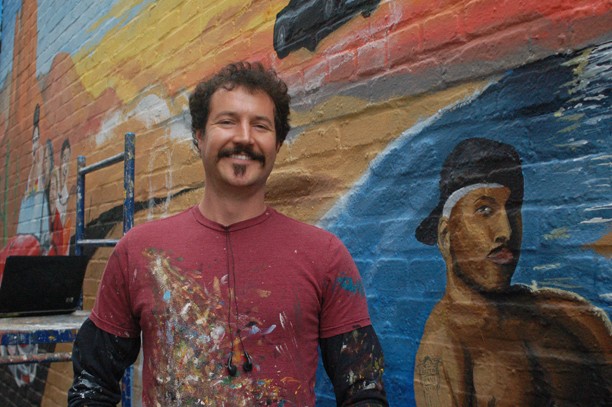In a dark alley in Tucson there exists a monument to wild color, inimitable youth and the enduring soul of the world as seen through art in the mind’s eye. His name is Joe Pagac.
Covered entirely in a striking smattering of paint, Pagac is a living extension of the work he creates: a colorful disarray that has become the focal point of downtown Tucson for the last three years. For in that once dark alley on the side of The Rialto Theatre, Pagac has been conducting a brilliant visual feat.
The muralist has been working with the Rialto painting a rotating number of murals for the varied shows that pass through it — a massive billboard of art for art. For each of the entertainers inside the theater, there has been a corresponding mural on the exterior wall. Only now is the mural taking on a degree of permanence.
In his final act, Pagac paints the last mural leisurely, decisively and not without a smidge of humor. Really though, LL Cool J riding a shark in the middle of the desert is funny. It is wildly amusing, intriguing — a cohesive collection of memories and colorful images. Featuring an island of the ill-fated 27 Club, a cartoonish car of both local and national music icons, it is charming and exudes a feeling of lasting presence.
With the development of the streetcar and other building renovations downtown, the mural has been resigned to the past. Pagnac said he realizes the demand for constant change in this day and age.
“There is something cool about looking at something, a painting, from 600 years ago, and being able to see it and know that is still relevant,” Pagac said.
He has been deprived that timeless feature with his murals on the side of the Rialto, constantly painting over previous work to feature the new. He said there is a drag on his otherwise enviable job. “It’s not as timeless … it’d be cool years from now to be able to look back and have my work preserved in years; that’s sad,” he said.
He said he enjoys the finality in a piece of art, and, as such, Pagac’s current mural will be gracing downtown Tucson for quite some time. Although his physical work has faded beneath layers of impermeable paint, there remains a lasting presence of his colorful image.
The mural exists as an integral part of Tucson, for it has evolved and taken shape with time, reflecting permanence in an otherwise flighty city.
Native to the area, he has remained in Tucson. He enthralls in the people, his home and — in case you haven’t caught on — he instills a vivid arts scene.
“There are really a lot of cool people in Tucson and a lot of people doing really interesting things. Except, everybody leaves,” he said.
Pagac, however, is here to stay. At least in his art.
Pagac, who started painting interior walls of wealthy people’s homes and moved to the bustling streets of greater Tucson, said he never thought he’d be here now.
“I thought I’d sell out, paint what was in other people’s souls; why would I paint what was in my own soul?”
Pagac’s soul can be found reflected, wondrously, on a wall in downtown. There is, after all, a degree of permanence in time.









